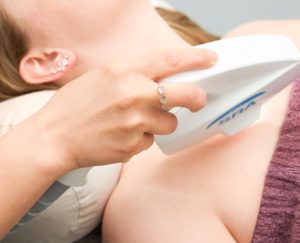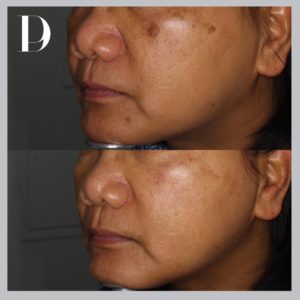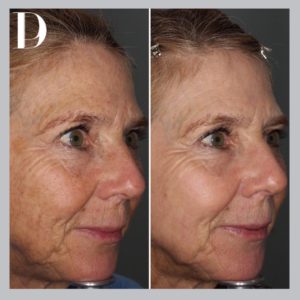Vancouver – it’s grey, dreary and wet outside, but indoors at Pacific Derm we are fired up for a busy season of brightening complexions and erasing the “sunny sins” of Summer. Turning the clock back on sun damage is not a paint-by-numbers process: let us walk you through the steps and options.
Your consultation
The first step to brightening your complexion is to perform a thorough assessment, formulate a diagnosis and assess your skin type. While some types of hyperpigmentation (traditional sun spot, “solar lentigo”) are readily treatable with devices, others like melasma or hyperpigmentation from previous inflammation such as acne (postinflammatory hyperpigmentation) require careful consideration before using lasers: make sure that you always consult with your Dermatologist.
Medical-grade skin care and more
Quality skin care is critical in any scenario: it can improve stubborn conditions that devices are not as good at treating and can prolong the investment you put in laser treatments by increasing the longevity of your results. Year-round daily sunscreen as the last step of your morning skin care regimen is proven to shield your skin from further UV damage. Vitamin C serums, brightening agents (such as kojic acid, tranexamic acid) and retinols are some of the other topical actives with the most science at protecting against hyperpigmentation. Some specific scenarios and medical skin conditions may require prescription treatments for optimal results.
Pew pew pew!
Lights and lasers have revolutionized the treatment of hyperpigmentation and carry the potential to bring transformative results. Our dermatologists and clinical staff at Pacific Derm will take into account your objectives, diagnosis, overall health and skin type to recommend a tailored treatment plan. Our wide array of devices allows us to address a range of skin conditions and customize treatment for specific skin tones, sensitivities, and individual goals. Though choosing the best treatment for you is a complex decision with multiple factors, we have compiled a “cheat sheet” to help you start the conversation during your consultation. This cheatsheet is a bit oversimplified – for instance we commonly do combination treatments when indicated. For any and all of these treatments, it is very important for tans to have faded and to avoid direct exposure to sunlight during recovery. This is mainly to prevent hyperpigmentation caused by the laser itself. Though the discolouration is usually temporary and resolves weeks after treatment, treating sun-tanned areas can cause unwanted complications – if you are in to treat it, we don’t want to cause it!
| Usual treatment area |
Targets pigment | Reduces blood vessels | Improves texture | Usual “down time” |
|
| IPL | Full-face, Neck & Chest | +++ | ++ | + | ~3-5 days |
| Classic pigment laser | Spot treatment | ++++ | ~5-7 days | ||
| Picosecond laser | Spot or full-face | +++ | ++ | ~3-5 days | |
| Fractional laser (Fraxel 1927) | Full-face | +++ | + | +++ | ~1 week |
Intense Pulsed Light (IPL) is a broadband light that targets “browns and reds” simultaneously. It relies on contrast and as such is best suited for fair-skinned patients. Pulses feel like a small elastic band being released onto the skin, and immediately after the procedure pigment appears darker and the skin more red. Over the next few days, dark spots shed like “coffee grounds”. Not all IPL treatments are created equal – our device carries a radiofrequency feature that helps with texture and our staff are trained to adjust the light dose to the reaction on your skin rather than repeat multiple “paint-by-numbers” treatments.

“Q-switched” or classic pigment laser, in contrast to IPL, is a device that targets pigment only – and it does so very effectively. Laser exposure feels like a hot zap, and spots that are treated appear darker and develop scale/crust during the recovery. We often reach for this device to spot-treat a problem area.

Picosecond laser relies on extremely short laser pulses of light to treat pigment. We often use it for tattoo removal, and it is also a device of choice when treating hyperpigmentation in our patients of East Asian and South Asian descent. So-called “pico” lasers result in less social down time and can also soften skin texture.
Last but not least is a personal favourite – fractionated laser resurfacing with Fraxel 1927 nm (the topic of its own blog post here). This device delivers an array of infrared laser energy to the skin to scatter pigment, brighten complexion, stimulate collagen and even treat scaly/rough types of sun damage. Expect to look lobster-red immediately after and quite pink for a few days, with a skin texture like sandpaper that will gently shed to reveal rejuvenated skin. I had this procedure done three days before the Christmas holiday last year and I was a real treat to look at! This laser is the ultimate “glow-getter”, and Fraxel Fridays are on repeat at the clinic !

Ready to elevate your complexion? Consultation is just a phone call away.